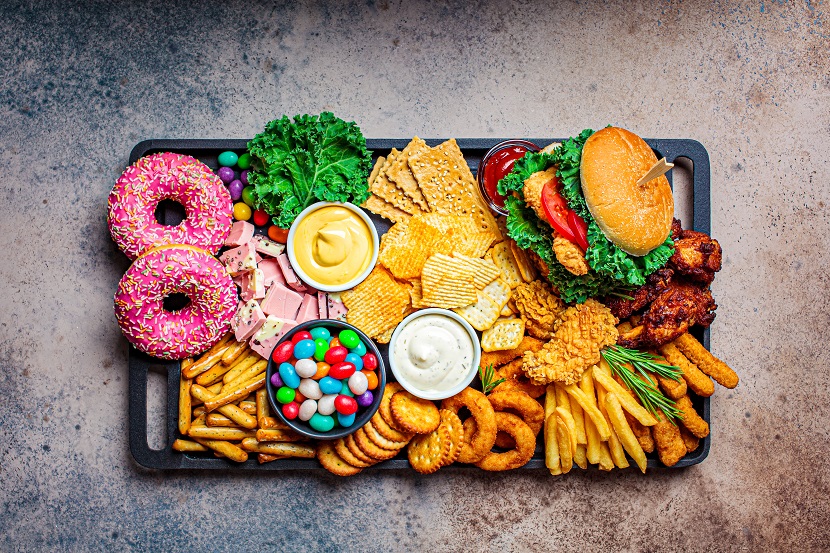
There is a strong relation between cell aging and the consumption of ultra-processed foods. This is what emerges from a study published on the American Journal of Clinical Nutrition, conducted by a team of Spanish researchers of the Universities of Navarra, Pamplona and Madrid, whose results were presented at the European and International Congress on Obesity (held from September 1st to September 4th, 2020).
But what are ultra-processed foods?
According to NOVA food classification, the products we buy can be divided into 4 groups, from unprocessed to ultra-processed, according to well-defined characteristics:
- Unprocessed and minimally processed foods (Group 1): this group includes fruit, vegetables, nuts, seeds, grains, beans, legumes and natural animal products such as eggs, fish and milk. These foods can be dried, crushed, roasted, frozen, boiled, or pasteurised, but contain no added ingredients
- Processed culinary ingredients (Group 2): this group includes oils, fats such as butter, vinegars, sugars and salt. These foods are not meant to be eaten alone, but usually they are eaten in association with foods in group one.
- Processed food (Group 3): this group includes foods that are usually made using a mix of ingredients from group 1 and 2. They include smoked and cured meats, cheeses, fresh bread, bacon, salted or sugared nuts, tinned fruit in syrup, beer and wine. The main purpose of the processing is to prolong the food’s life or accentuate its taste.
- Ultra-processed food and beverage (Group 4): Ultra-processed foods usually contain ingredients that you would not add when cooking at home. It is difficult to recognise the name of these ingredients because many of them are chemicals, colourings, sweeteners and preservatives. They are characterised by a long list of ingredients, they are ready to eat, they have a long expiry date and, in general, they are very flavourful.
According to the study, those who consumes more than 3 portions per day of ultra-processed food have a double probability to have shorter telomeres.
What are telomeres?
They are a sort of security helmet at the end of chromosomes: it is neutral genetic material that does not codify any function, but that is essential to preserve the integrity of chromosomes. During the several cell replications, the telomeres shorten. It is a physiological operation that comes with cell and physical aging, but according to the result of this study, the excessive consumption of ultra-processed food would accelerate this process.
The researchers analysed the DNA of saliva samples provided by 645 men and 241 women, with an average age of 67-68. In addition to this, people were asked to register carefully what and how much industrial food they ate daily.
The authors divided the subjects into 4 groups, according to the consumption of ultra-processed foods: low consumption of ultra-processed food (less than 2 portions per day), medium-low consumption (from 2 to 2.5 portions per day), high-medium consumption (from more than 2.5 to 3 portions per day) and high consumption (more than 3 portions per day).
According to the results:
- The subjects eating large quantities of ultra-processed food had a higher probability to show depression, high blood pressure, overweight or obesity, and in general a higher probability of death due to these causes.
- In the group with the highest consumption, the probability of a family history of heart diseases, diabetes and excessive blood fat was higher.
- The subjects belonging to this group were more used to have snacks between meals, to consume more fats, sodium, cholesterol, fast food and processed meat. At the same time, they assumed less carbohydrates, proteins, fibres, olive oil, fruit, vegetables, and other micronutrients.
- Individuals consuming more ultra-processed food had a reduced probability to adopt the Mediterranean diet.
- Last but not least: the risk of premature shortening of telomeres increased considerably with the increasing consumption of heavily processed food. Passing from a low to a medium-low consumption, the risk augmented by 29%; from a medium-low to a high-medium one the risk was of 40% and, lastly, from a high-medium to a high consumption the risk jumped to 82%.
To conclude, although it would be necessary to have more evidence to confirm this telomeres’ activity, this study adds to many others which confirm the harmful effects of ultra-processed food on health.
Despite the convenience and their savoury taste (due to the high content of salt, fats and sugars), ultra-processed foods can be considered advantageous only for who produce and sell them, since that their excessive consumption has been associated to the outbreak of several chronic pathologies: hypertension, obesity, metabolic syndrome, depression, type-2 diabetes and different forms of cancer.
Eating fresh and minimally processed food and preferring home preparation, combined with a healthy and active lifestyle, proves to be the best way to preserve our health!
Bibliography:
https://www.bbc.co.uk/food/articles/what_is_ultra-processed_food